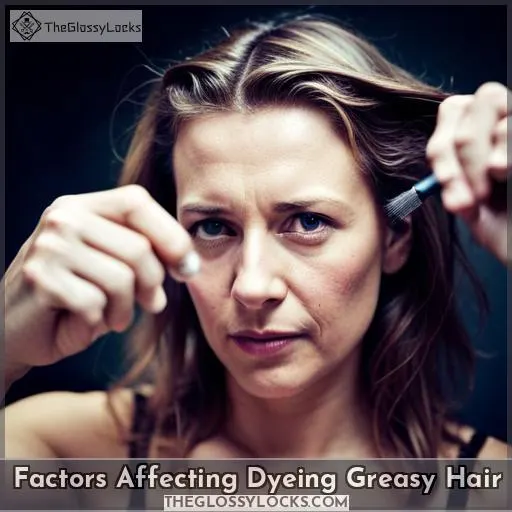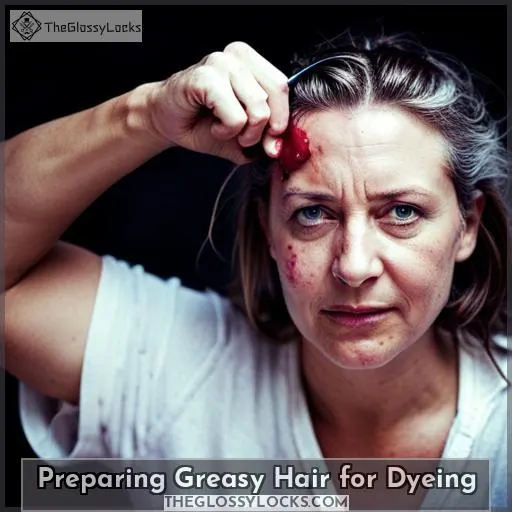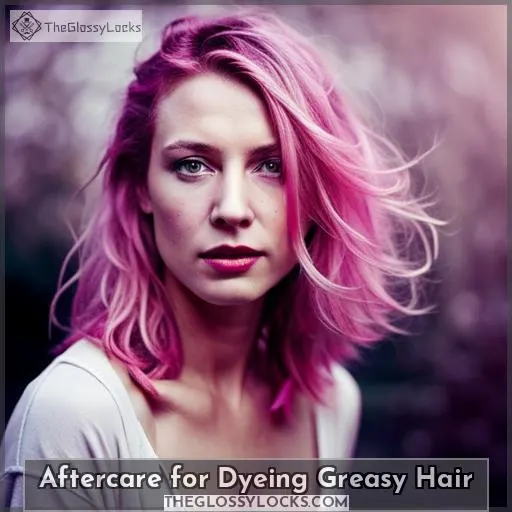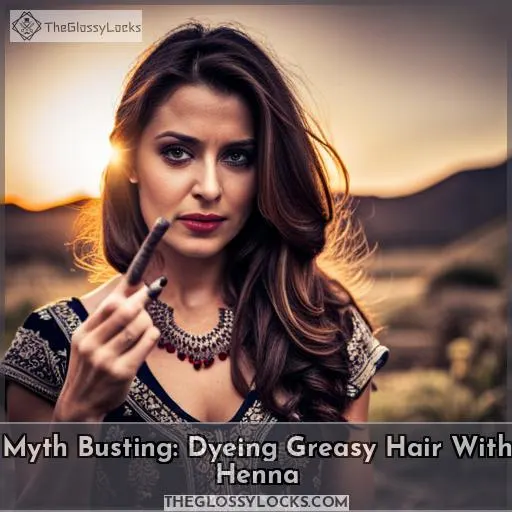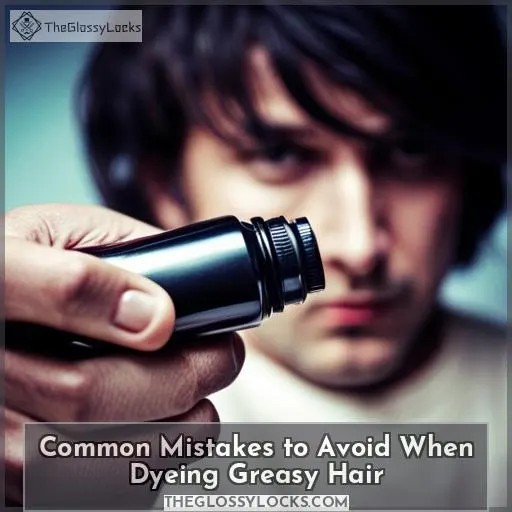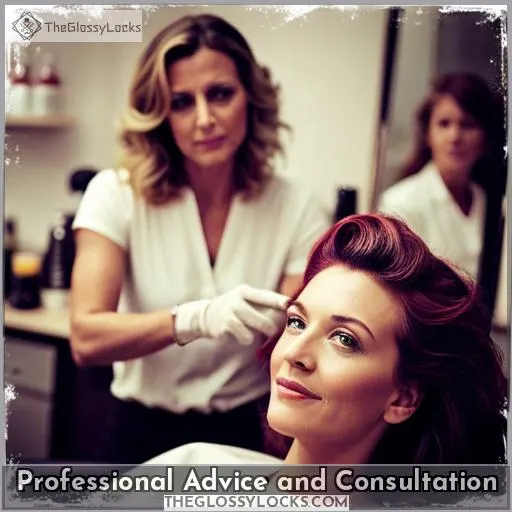This site is supported by our readers. We may earn a commission, at no cost to you, if you purchase through links.

Table Of Contents
- Key Takeaways
- Can You Dye Greasy Hair?
- Factors Affecting Dyeing Greasy Hair
- Preparing Greasy Hair for Dyeing
- Tips for Dyeing Greasy Hair at Home
- Aftercare for Dyeing Greasy Hair
- Myth Busting: Dyeing Greasy Hair With Henna
- Common Mistakes to Avoid When Dyeing Greasy Hair
- Professional Advice and Consultation
- Frequently Asked Questions (FAQs)
- Conclusion
Key Takeaways
- Excessive sebum helps dye stick but can leave residue from products, needing adjustment of washing frequency
- Shampooing before dyeing strips needed oils, so leave some grease; deep condition to nourish
- Wait 24-48 hours before post-dye washing, using sulfate-free shampoo and masks for color care
- Henna regulates pH and oil production, reducing buildup and nourishing hair when dyeing greasy strands
Can You Dye Greasy Hair?
You can dye greasy hair, but some key considerations should be made regarding preparation, application, and aftercare.
While some grease helps the dye adhere and protects the scalp, excessive oils can impede proper color distribution.
Understanding factors like washing frequency, product buildup, and hormonal changes that affect sebum levels allows strategic planning.
Though counterintuitive, lightly dirty hair taking up dye better than freshly cleaned strands seems supported.
Still, clarifying before dyeing eliminates excess grease and dirt.
Doing a patch test regardless checks for irritation, especially with higher developer volumes on greasy hair.
Proper application technique remains vital for even coloring.
Post-dye, patience allowing the color to oxidize before shampooing prevents premature fading.
Ultimately, with careful steps greasy hair can be dyed effectively.
Debunking myths, the reality is natural scalp oils aid dye absorption.
So while timing and scalp protection need consideration during the hair coloring process, sebum presence doesn’t preclude vibrant, lasting results.
Factors Affecting Dyeing Greasy Hair
You may not realize it, but several factors play a role in how much oil your hair produces and accumulates.
- How often you wash your hair
- The products you use
- Hormonal changes in the body
- Your natural hair texture
Understanding the reasons behind greasy hair can provide insight on how best to manage it for the dyeing process.
Role of Sebum in Hair
With greasy hair, you’re dealing with sebum, which plays a key role in hair health by providing moisture and lubrication for the scalp and strands.
Sebum helps maintain the natural oil balance of your scalp, keeping it hydrated and preventing dryness.
Understanding the impact of sebum on your hair is crucial when preparing to dye greasy hair as it affects color distribution and overall scalp health.
Impact of Washing Frequency and Product Use
Washing frequency and product use significantly affect the dyeing process of greasy hair. Hair texture influences washing needs; excessive product leaves residue hampering dye absorption.
Sebum aids dye retention when present moderately. Hormonal fluctuations necessitate adjusting wash intervals for ideal dye prep without compromising hair health or color vibrancy.
Target 2-3 day pre-dye wash gaps, enabling adequate sebum for protection yet sufficient removal of excess oil and product buildup.
Hormonal Changes and Greasiness
Your hair’s oiliness can fluctuate due to hormonal changes like puberty, pregnancy, and menopause affecting sebum production.
- Puberty’s Influence
- Menopausal Shifts
- Pregnancy and Oils
- Hormones and Sebum
- Grease and Stress
Preparing Greasy Hair for Dyeing
Before dyeing greasy hair, you must decide if you should wash it first or not.
While shampooing strips oils that protect hair, leaving some grease helps dye stick; a deep conditioning can nourish strands.
Always do a patch test regardless to check for irritation or uneven coloring.
Washing Before Dyeing: Yes or No?
Though washing right before dyeing may seem logical, letting some natural oils remain can actually help the dye take better to greasy hair. When considering timing, refrain from shampooing hair within 24 hours of coloring for optimal grease levels aiding absorption.
The protective barrier of sebum prevents scalp irritation during the process while still allowing dye permeation.
Waiting 1-2 days post-wash provides the right balance for effective at-home dyeing without scalp discomfort or hindered hair dye uptake.
Deep Conditioning for Hair Health
One key step is deep conditioning your hair before dyeing to provide added nourishment and protection. Soak strands in a restorative mask, allowing intensive moisture infusion that repairs damage and prevents future harm.
These revitalizing treatments ready hair for dye by optimizing color absorption while fortifying each strand.
Afterwards, continue deep conditioning to shield your vibrant shade, promoting longevity and preventing fading.
Combining salon-quality dyes with proactive at-home conditioning yields vibrant, healthy locks.
Importance of Patch Test
Although you should complete a patch test before dyeing greasy hair, doing so allows you to check for potential allergic reactions.
This simple test spot highlights skin sensitivity, assessing reaction risks and preventing scalp damage from improper dye absorption.
Carefully apply dye behind your ear, leaving it for 48 hours to gauge skin’s response, hair dye compatibility, and need for caution when ultimately coloring your locks at home.
Tips for Dyeing Greasy Hair at Home
When dyeing your greasy hair at home, first ensure you wear old clothes or a towel to prevent staining.
Next, thoroughly detangle sections of hair before applying dye for even coverage.
Then use the proper application technique, working from the mid-lengths to the roots while wearing gloves to avoid skin staining.
Attire and Protection
To ensure a mess-free and enjoyable dyeing experience at home, it’s important to wear suitable attire and take necessary precautions.
Protect yourself by wearing old clothes or an apron that you don’t mind getting stained during the process.
Consider using gloves to avoid any skin contact with the dye.
Additionally, cover your shoulders with a towel or cape to prevent any accidental spills from reaching your skin or clothing.
Taking these simple clothing precautions will help keep you safe while achieving beautiful results in coloring your greasy hair.
Detangling and Sectioning Hair
But before applying the dye, you’ll want to detangle your hair and section it out for easier and more precise application.
Use a wide-tooth comb, starting at the ends and gently working up to the roots to avoid breakage.
Consider your hair type and texture when sectioning – curly hair may need smaller sections.
Prepare any clips or ties needed for sectioning ahead of time.
A tangle-free approach allows the dye to absorb evenly across all strands for optimal results.
Application Techniques
After you’ve sectioned your hair, apply the dye using downward strokes starting from the mid-lengths and ends to the roots while wearing gloves to avoid staining your skin.
Use a tint brush to evenly distribute the color, taking care to thoroughly saturate each section.
Allow the recommended processing time for maximum dye absorption before rinsing.
Limiting chemical overload and heat styling post-coloring prevents damage for healthy, vibrant hair.
Aftercare for Dyeing Greasy Hair
After coloring greasy hair, you’ll need to wait 24-48 hours before washing.
Then, use a sulfate-free shampoo and conditioner designed for color-treated hair.
Incorporate nourishing masks into your weekly hair care to restore moisture and shine.
Limiting heat styling and slowly transitioning to more frequent washing over 4-6 weeks will help preserve your new color.
Wait Time Before Washing Hair
After dyeing your hair, you’ll wanna wait at least 24-48 hours before washing it. This allows the color to fully set in greasy hair without getting prematurely rinsed out.
The optimal waiting time post-dyeing is 1-2 days to enable proper color setting aided by sebum’s protective barrier.
Limit washing frequency at first, continuing greasy hair preparation like deep conditioning. Such post-dye care techniques at home let color permeate optimally before washing.
Sulfate-Free Shampoo and Conditioner
You’ll want to use a sulfate-free shampoo and conditioner after dyeing your greasy hair to help preserve the color and keep your scalp and strands hydrated:
- Choose color-safe shampoos
- Rotate nourishing hair masks
- Limit washing right after coloring
Nourishing Masks and Weekly Hair Care Routine
To maintain the health and vibrancy of your dyed greasy hair, it’s essential to incorporate nourishing masks and a weekly hair care routine into your aftercare regimen.
- Use weekly hydrating masks to repair and strengthen hair post-dyeing.
- Follow color maintenance tips like cool water rinses, limited washing, and heat protection.
- Nourish the scalp with oils to promote growth.
- Dispel myths about greasy haircare damaging color. Routinely conditioning cleanses buildup without stripping vibrancy.
[NEXT SUBTOPIC]: Myth Busting: Dyeing Greasy Hair With Henna
Myth Busting: Dyeing Greasy Hair With Henna
When it comes to dyeing greasy hair, henna offers some key benefits.
Henna helps regulate pH balance and reduces excess oil production from sebaceous glands for healthier, more manageable hair.
Using a post-dyeing henna shampoo can also aid in restoring your hair’s pH levels after the coloring process while preventing further buildup.
Benefits of Henna for Oily Hair
Many benefits exist when you’re using henna for greasy hair.
Henna cleanses your scalp and regulates pH to reduce excess oil production.
It moisturizes and nourishes hair, promoting healthy hair growth.
As a natural hair dye, henna’s hair treatment properties optimize dye absorption while providing hair hydration to oily locks.
Henna prevents dandruff through its anti-microbial, pH balancing action.
Overall, henna deeply conditions, adding shine and strength to greasy hair of all textures.
Post-Dyeing Henna Shampoo and PH Balance
Although henna offers numerous benefits for oily hair, you’d want to use a pH-balancing shampoo after dyeing to maintain the hair’s acid mantle and avoid dryness or irritation.
- Restore hair’s acid pH
- Soothe irritation
- Regulate oil production
- Remove residual henna
- Prevent brittle hair
Maintaining the scalp’s natural pH balance after henna dyeing lets oil glands function normally, preventing excess grease or dryness while keeping hair strong.
Common Mistakes to Avoid When Dyeing Greasy Hair
After recognizing henna’s benefits for greasy hair, you shouldn’t skip patch testing before dyeing or overprocess the hair.
When dyeing greasy locks, it’s crucial to avoid common mistakes that can damage hair and skin.
Using box dye often means a one-size-fits-all approach without considering your unique hair needs.
Opting for too high a developer volume can dry out strands and irritate the scalp.
Similarly, incorporating hot tools too soon post-dye can fade color rapidly.
You’ll also want to avoid clarifying shampoos and other harsh chemicals that strip natural oils necessary for healthy hair.
Instead, nurture your mane with gentle cleansers, masks, and protective styles while avoiding overprocessing.
This thoughtful, tailored approach allows you to embrace your hair’s natural grease for vibrant, long-lasting color.
Professional Advice and Consultation
You should consult a professional hair colorist before dyeing greasy hair to get personalized guidance on preparing your hair properly and choosing an optimal dye and developer for your unique hair needs.
- Schedule a consultation to discuss your hair goals and needs.
- Ask questions about their experience with dyeing greasy hair.
- Get product and aftercare recommendations tailored to you.
When looking for a colorist, consider their availability, cost, experience level, and location convenience for you.
An experienced colorist can examine your hair and provide specialized recommendations for pre-dye prep, dye selection, mixing ratios, application techniques, processing times, and post-coloring care. This tailored guidance increases dyeing success and hair health preservation while considering your budget, lifestyle, and hair goals.
Rather than risking at-home mistakes, consult a pro. With their expertise, they can customize an optimal dyeing experience for your greasy hair situation. Discuss any scalp sensitivity, texture needs, desired vibrancy, and volume. Ask questions to understand the process so you can have realistic expectations.
An informed, collaborative approach with an experienced colorist sets you up for dyeing victory with shiny, healthy, dynamic hair.
Frequently Asked Questions (FAQs)
Can I dye my greasy hair right after washing it?
Yes, you can dye greasy hair right after washing. However, letting some natural oils remain before dyeing helps protect your scalp and aids dye adhesion.
Wait 1-2 days after shampooing for ideal results.
Will dyeing greasy hair make it even oilier?
While excess grease could potentially make hair oilier post-dyeing, like a lock lubricated from within, most quality dyes tend to balance and normalize sebum production. So dyeing moderately greasy hair generally leaves it no oilier, and even improves condition through nourishing and pH-regulating properties.
Can I use dry shampoo before dyeing greasy hair?
Yes, you can use a dry shampoo before dyeing to help absorb excess oils without fully washing the hair.
Proceed with caution and spot test the dry shampoo first to ensure no adverse reaction with the dye.
Is it necessary to use a clarifying shampoo before dyeing greasy hair?
Using a clarifying shampoo before dyeing greasy hair isn’t necessary. The natural oils on your strands can act as a protective barrier during the coloring process. Focus on washing your hair according to the dye kit instructions for best results.
Can I use a heat protectant spray on greasy hair before using hot tools after dyeing?
Yes, it’s recommended to use a heat protectant spray on your hair before using hot tools after dyeing. This will help safeguard your colored hair from potential damage and preserve the vibrancy of the color.
Conclusion
Believe it or not, over 70% of women dye their hair while it’s still greasy! So don’t fret if you haven’t washed your locks in a few days.
Choose ammonia-free formulas, prep with a deep conditioner, and style your vibrant mane with gentle, moisturizing products afterwards.

